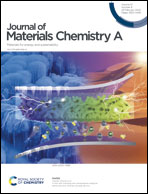Enhanced cocatalyst-free photocatalytic H2 evolution by the synergistic AIE and FRET for an Ir-complex conjugated porphyrin†
Abstract
A T-Ir complex was conjugated to a porphyrin ring via a phenylene linkage to afford a new ZnP-T-Ir photosensitizer which exhibits aggregation-induced emission (AIE) for the T-Ir unit, inhibition of aggregation caused by quenching (ACQ) of the porphyrin unit and an efficient Förster resonance energy transfer (FRET) from the T-Ir energy donor to the porphyrin energy acceptor. The ZnP-T-Ir system exhibits highly efficient cocatalyst-free photocatalytic hydrogen evolution (PHE) with a rate (ηH2) of 1.42 mmol g−1 h−1, which is 71-fold higher than that of the related control porphyrin, ZnP-T (0.02 mmol g−1 h−1) that does not contain the Ir-complex. The high ηH2 of ZnP-T-Ir in cocatalyst-free PHE can be ascribed to the conjugation of the T-Ir moiety along with the synergistic effect of AIE, ACQ inhibition, and FRET, which further led to efficient UV-visible light-harvesting, a longer photoexcited electron lifetime, and thereby a more efficient electron transfer rate from the photoexcited porphyrin to the proton used for water reduction.



 Please wait while we load your content...
Please wait while we load your content...